Exploring the Association of Spatial Capital and Economic Diversity in the Tourist City of Surat Thani, Thailand
Abstract
:1. Introduction
1.1. The Socio-Economics of Urban Morphology
1.2. The Definition and Measurement of Spatial Capital
2. Case Study and Methodology
2.1. The Case Study Area
2.2. Analytical Framework and Data Collection
2.3. Measuring Economic Diversity
2.4. Space Syntax Measures Spatial Integration
3. Results and Discussion
3.1. Spatial Distribution of Urban Economic Activities and Diversity
3.2. Spatial Capital Measured and Its Implication for City Development by Space Syntax
3.3. Investigating the Spatial Capital Based on Accessibility to Economic Activities
4. Conclusions
Author Contributions
Funding
Institutional Review Board Statement
Informed Consent Statement
Data Availability Statement
Acknowledgments
Conflicts of Interest
References
- Oliveira, V. Urban Morphology. An Introduction to the Study of the Physical Form of Cities; Springer: Cham, Switzerland, 2016. [Google Scholar]
- Krier, R. Urban Space; London Academic Editions: London, UK, 1979. [Google Scholar]
- Cozen, M.R.G. Historical Townscapes in Britain: A Problem in Applied Geography; Newcastle upon Tyne Orien Press: Newcastle, Australia, 1966. [Google Scholar]
- Paksookcharoen, K. Urban discourses through morphological structures. Acad. J. Archit. 2011, 60, 63–76. [Google Scholar]
- Netto, V. Reflections on space syntax as sociospatial theory. In Proceedings of the 10th International Space Syntax Symposium, London, UK, 13–17 July 2015; pp. 9–11. [Google Scholar]
- Hillier, B. The Morphology urban space: The evolution of syntactic approach. Archit. Behav. 1987, 3, 205–216. [Google Scholar]
- Moudon, A.V. Urban morphology as an emerging interdisciplinary field. Urban Morphol. 1997, 1, 3–10. [Google Scholar] [CrossRef]
- Stephen, C.; Mark, F.; Leanne, G.R.; Andrew, M.S. Public Space; Cambridge University: Cambridge, UK, 1995. [Google Scholar]
- Sangsehanat, S. Morphological Identity of Bangkok; Thailand Research Fund: Bangkok, Thailand, 2018. [Google Scholar]
- Marcus, L. Spatial capital and how to measure it: An outline of an analytical theory of the social performativity of urban form. In Proceedings of the 6th International Space Syntax Symposium, Istanbul Technical University, Istanbul, Turkey, 12–15 June 2007; pp. 2–12. [Google Scholar]
- CABE. The Councillor’s Guide to Urban Design; Springer: London, UK, 2003. [Google Scholar]
- Marcus, L. Spatial capital a proposal for an extension of space syntax into a more general urban morphology. J. Space Syntax 2010, 1, 30–40. [Google Scholar]
- Thai, H.M.H.; Stevens, Q.; Rogers, J. The evolution of pathways linking main streets and marketplaces to home-based business locations in Hanoi, Vietnam. J. Urban. 2020, 15, 1–28. [Google Scholar] [CrossRef]
- Urden, A. Greenacre Park: A Study; Project for Public Space: New York, NY, USA, 1977. [Google Scholar]
- William, H.W. The Social Life of Small Urban Spaces; The Conservation Foundation: Washington, DC, USA, 1980. [Google Scholar]
- Hidayati, I.; Yamu, C.; Tan, W. Realised pedestrian accessibility of an informal settlement in Jakarta, Indonesia. J. Urban. 2020, 26, 124–140. [Google Scholar] [CrossRef]
- History of Surat Thani. Available online: https://www.cgd.go.th/cs/srt/srt/History.html (accessed on 15 June 2021).
- Kulachol, K. What is Urban Design—40 Years of Pursuit of Answers; Silpakorn University: Bangkok, Thailand, 2002. [Google Scholar]
- Narvaez, L.; Penn, A.; Griffiths, S. Space Syntax Economics: Decoding accessibility using property value and housing price in Cardiff, Wales. In Proceedings of the Eighth International Space Syntax Symposium, Santiago, Chile, 3–6 January 2012; Greene, M., Reyes, J., Castro, A., Eds.; PUC: Santiago, Chile; pp. 1–19. [Google Scholar]
- Hillier, B.; Hanson, J. The Social Logic of Space; Cambridge University Press: Cambridge, UK, 1989. [Google Scholar]
- Xiao, Y.; Li, Z.; Webster, C. Estimating the mediating effect of privately-supplied green space on the relationship between urban public green space and property value: Evidence from Shanghai, China. Land Use Policy 2016, 54, 439–447. [Google Scholar] [CrossRef]
- Law, S.; Karimi, K.; Penn, A.; Chiaradia, A.J. Measuring the Influence of Spatial Configuration on the Housing Market in Metropolitan London. In Proceedings of the Ninth International Space Syntax Symposium, Seoul, Korea, 31 October–3 November 2013; Kim, Y.O., Park, H.T., Seo, K.W., Eds.; Sejong University: Seoul, Korea; pp. 7–20. [Google Scholar]
- Topcu, M.; Kubat, A.S. The analysis of urban features that affect land values: The case of Istanbul. In Proceedings of the 7th International Space Syntax Symposium, Stockholm, Sweden, 8–11 June 2009; Koch, D., Marcus, L., Steen, J., Eds.; Royal Institute of Technology: Stockholm, Sweden, 2009; pp. 1–9. [Google Scholar]
- Jeong, S.K.; Ban, Y.U. Spatial Configuration for the Revitalisation of a Traditional Market: The Case of Yukgeori Market in Cheongju, South Korea. J. Sustain. 2020, 12, 2937. [Google Scholar] [CrossRef]
- Majumdar, A.; Sliuzas, R.V.; Munshi, T.; Brussel, M.J.G. Exploring the relationship between urban roads, urban form and economic activity in Ahmedabad using space syntax. In Proceedings of the GIS-T 2009 international workshop on GIS for transportation, Wuhan, China, 4–6 December 2009; pp. 1–6. [Google Scholar]
- Thomas, C.J.; Bromley, R.D. Retail Revitalization and Small Town Centres: The Contribution of Shopping Linkages. Appl. Geogr. 2003, 23, 47–71. [Google Scholar] [CrossRef]
- Ye, Y.; van Nes, A. Quantitative tools in urban morphology: Combining space syntax, spacematrix and mixed-use index in a GIS framework. Urban Morphol. 2014, 18, 97–118. [Google Scholar] [CrossRef]
- Conzen, M.P. The elusive common denominator in understanding urban form. Urban Morphol. 2010, 14, 55–58. [Google Scholar] [CrossRef]
- Stanilov, K. Bridging the gap between urban morphology and urban modelling. Urban Morphol. 2010, 14, 123–144. [Google Scholar]
- Ye, Y.; Yeh, A.; Zhuang, Y.; van Nes, A.; Liu, J. “Form Syntax” as a contribution to geodesign: A morphological tool for urbanity-making in urban design. Urban Des. Int. 2017, 22, 73–90. [Google Scholar] [CrossRef]
- de Koning, R.; van Nes, A. How two diverging ideologies impact the location of functions in relation to spatial integration in arctic settlements space syntax analyses of settlements closest to the North Pole. In Proceedings of the 12th International Space Syntax Symposium, Beijing, China, 8–13 July 2019; pp. 1–14. [Google Scholar]
- Sun, M.; Meng, Q. Using spatial syntax and GIS to identify spatial heterogeneity in the main urban area of Harbin, China. Front. Earth Sci. Environ. Inform. Remote Sens. 2022, 10, 893414. [Google Scholar] [CrossRef]
- van Nes, A.; Yamu, C. Space Syntax Applied in Urban Practice. Introd. Space Syntax. Urban Stud. 2021, 1, 213–237. [Google Scholar] [CrossRef]
- Bunruamkaew, K.; Murayam, Y. Site Suitability Evaluation for Ecotourism Using GIS & AHP: A Case Study of Surat Thani Province, Thailand. Procedia-Soc. Behav. Sci. 2011, 21, 269–278. [Google Scholar] [CrossRef]
- Praneetham, C.; Thathong, K.; Thiengkamol, N. Travel behaviors of Thai and foreign tourists traveling to Surat Thani province. In Proceedings of the 23rd International Academic Conference, Venice, Italy, 27 April 2016; pp. 400–407. [Google Scholar]
- Jarernpornnipat, A.; Pedersen, O.; Jensen, K.; Boromthanarat, S.; Vongvisessomjai, S.; Chonchuenchob, P. Sustainable Management of Shellfish Resources in Bandon Bay, Gulf of Thailand. J. Coast. Conserv. 2003, 9, 135–146. [Google Scholar] [CrossRef]
- Bunruamkaew, K.; Murayama, Y. Land Use and Natural Resources Planning for Sustainable Ecotourism Using GIS in Surat Thani, Thailand. Sustainability 2012, 4, 412–429. [Google Scholar] [CrossRef]
- van Nes, A.; Yamu, C. Empirical Data Collection and Analysis, and Connecting Data with Space Syntax. In Introduction to Space Syntax in Urban Studies; Springer: Cham, Switzerland, 2021. [Google Scholar] [CrossRef]
- Pansuwan, A.; Routray, J.K. Policies and pattern of industrial development in Thailand. GeoJournal 2011, 76, 25–46. [Google Scholar] [CrossRef]
- Yan, L.; Wang, D.; Zhang, S.; Ratti, C. Understanding urban centers in Shanghai with big data: Local and non-local function perspectives. Cities 2021, 113, 103–156. [Google Scholar] [CrossRef]
- Hu, C.; Liu, W.; Jia, Y.; Jin, Y. Characterization of territorial spatial agglomeration based on POI data: A case study of Ningbo city, China. Sustainability 2019, 11, 5083. [Google Scholar] [CrossRef]
- Zhou, N. Research on urban spatial structure based on the dual constraints of geographic environment and POI big data. J. King Saud Univ. Sci. 2022, 34, 101–887. [Google Scholar] [CrossRef]
- Basic Information of Surat Thani Province. Available online: https://www.suratcity.go.th (accessed on 15 June 2021).
- Peponis, J.; Hajinikoloaou, E.; Livieratos, C.; Fatouros, D.A. The spatial core of urban culture. Ekistics 1989, 56, 43–55. [Google Scholar]
- Simpson, E.H. Measurement of diversity. Nature 1949, 163, 142–155. [Google Scholar] [CrossRef]
- Rashid, M. Space syntax: A network-based configurational approach to studying urban morphology. In The Mathematics of Urban Morphology; Birkhäuser: Basel, Switzerland, 2019; pp. 199–251. [Google Scholar]
- Atakara, C.; Allahmoradi, M. Investigating the Urban Spatial Growth by Using Space Syntax and GIS—A Case Study of Famagusta City. ISPRS Int. J. Geo-Inf. 2021, 10, 638. [Google Scholar] [CrossRef]
- Soja, E.W. The city and spatial justice. In Proceedings of the International Conference Spatial Justice, Nanterre, France, 12–14 March 2008; pp. 1–5. [Google Scholar]
- Lamprecht, M. Space syntax as a socio-economic approach: A review of potentials in the polish context. Misc. Geogr.-Reg. Stud. Dev. 2022, 26, 5–14. [Google Scholar] [CrossRef]
- Lee, S.; Kyung, W. Combining space syntax with GIS-based built environment measures in pedestrian walking activity. In Proceedings of the Ninth International Space Syntax Symposium, Seoul, Korea, 31 October–3 November 2013; Sejong University: Seoul, Korea, 2013; pp. 1–14. [Google Scholar]
- Srinurak, N.; Mishima, N. Urban Axis and City Shape Evaluation through Spatial Configuration in ‘Lan Na’ Northern Thailand Historic City. City Territ. Archit. 2017, 4, 55. [Google Scholar] [CrossRef]
- Dalton, N.S. Synergy, Intelligibility and Revelation in Neighbourhood Places; University of London: London, UK, 2010. [Google Scholar]
- Xing, Z.; Guo, W. A New Urban Space Analysis Method Based on Space Syntax and Geographic Information System Using Multisource Data. ISPRS Int. J. Geo-Inf. 2022, 11, 297. [Google Scholar] [CrossRef]
- Van Nes, A.; Berghauser Pont, M.; Mashhoodi, B. Combination of Space syntax with space matrix and the mixed use index: The Rotterdam South test case. In Proceedings of the 8th International Space Syntax Symposium, Santiago, Chile, 3–6 January 2012; pp. 1–29. [Google Scholar]
- Karimi, K. Space syntax: Consolidation and transformation of an urban research field. J. Urban Des. 2012, 23, 1–4. [Google Scholar] [CrossRef]
- Alalouch, C.; Al-Hajri, S.; Naser, A.; Al Hinai, A. The impact of space syntax spatial attributes on urban land use in Muscat: Implications for urban sustainability. Sustain. Cities Soc. 2019, 46, 101417. [Google Scholar] [CrossRef]
- Chen, X. Research on the Application of Space Syntax in Urban Planning. World J. Eng. Technol. 2017, 5, 29–35. [Google Scholar] [CrossRef]
- Mohamed, A. Space syntax theory and its contribution to urban design. In Handbook of Research on Digital Research Methods and Architectural Tools in Urban Planning and Design; Abusaada, H., Vellguth, C., Elshater, A., Eds.; IGI Global: Hershey, PA, USA, 2019; pp. 203–222. [Google Scholar]
- Bonett, D.G.; Wright, T.A. Sample size requirements for estimating Pearson, Kendall and Spearman correlations. Psychometrika 2000, 65, 23–28. [Google Scholar] [CrossRef]
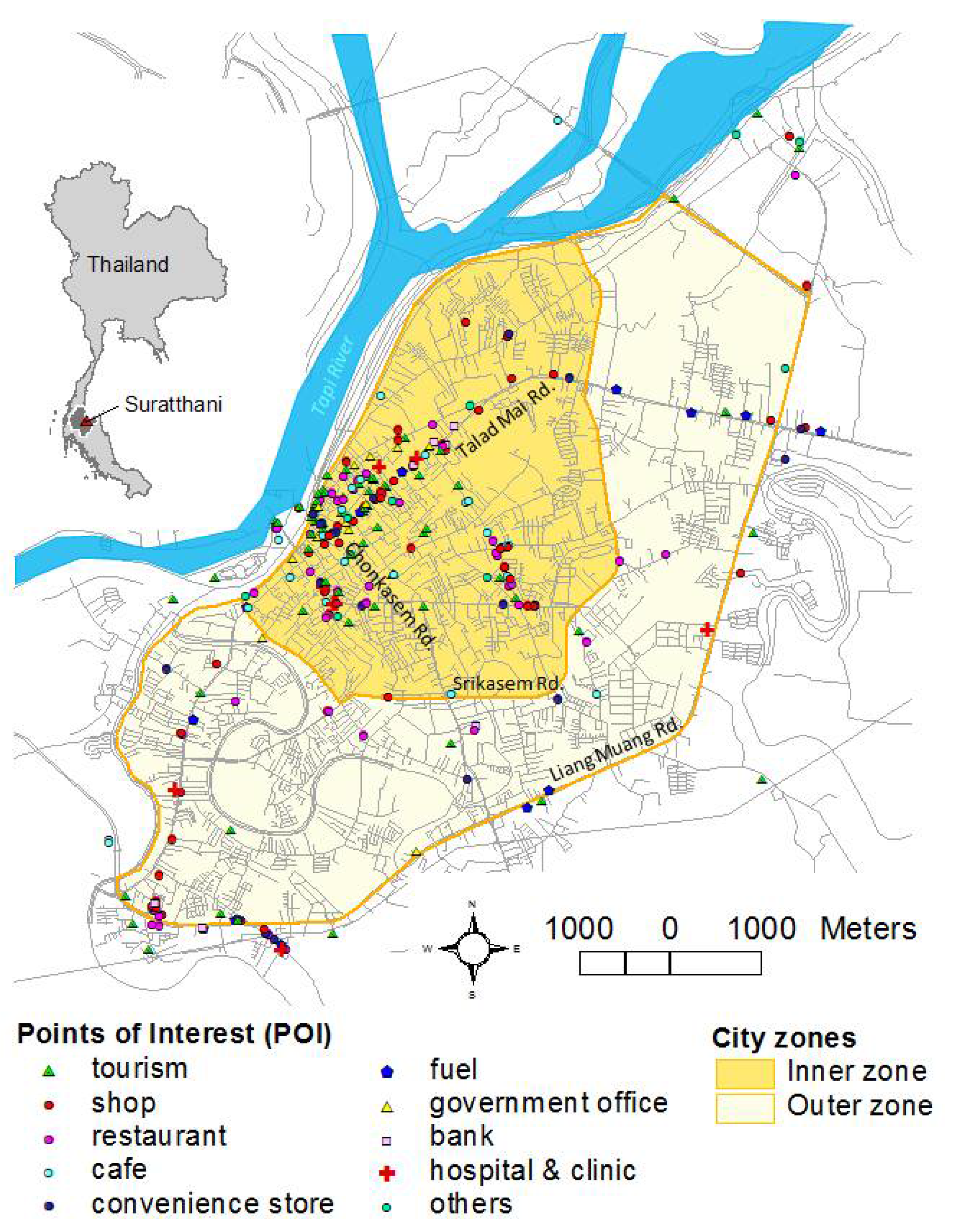


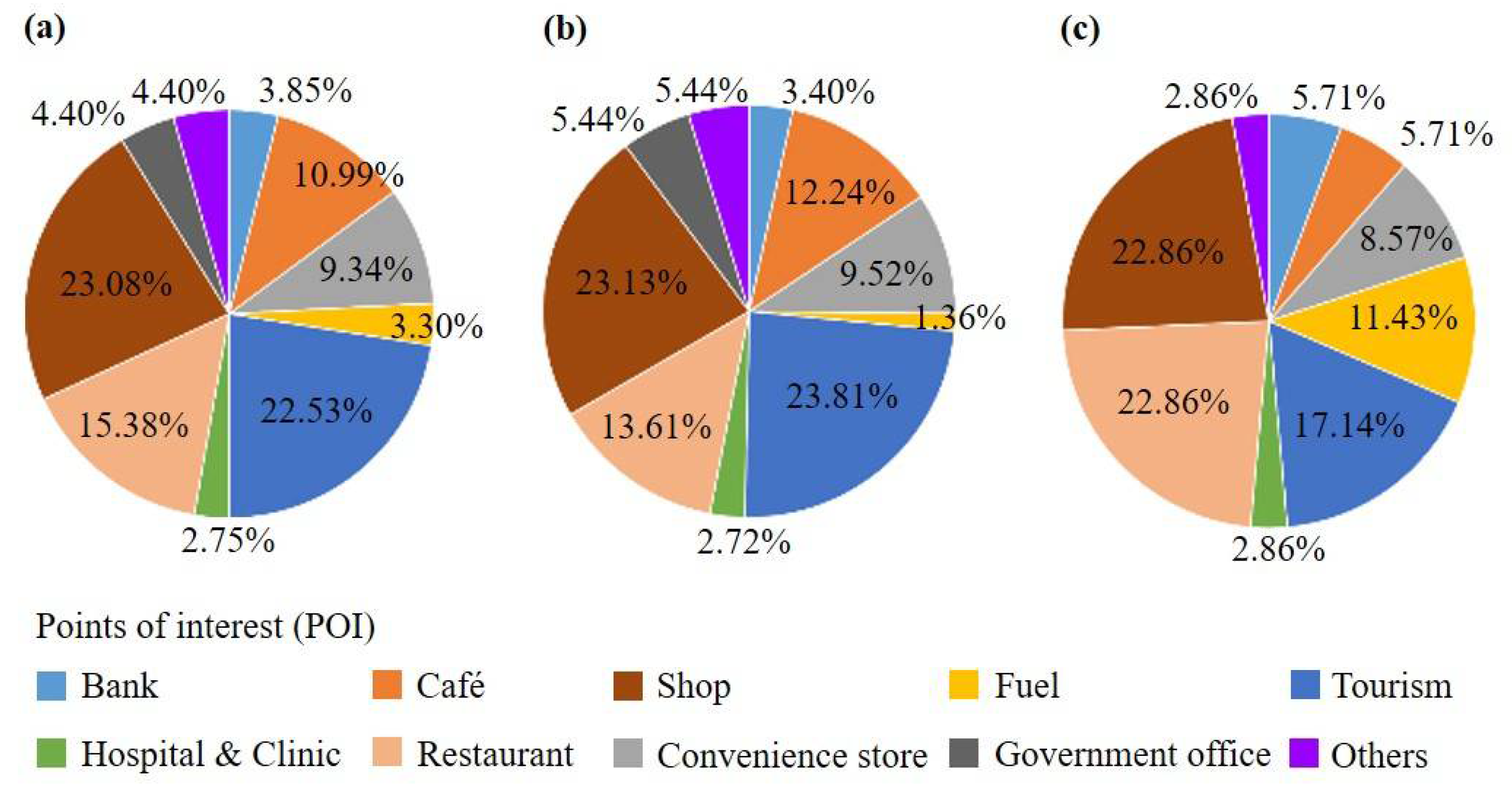


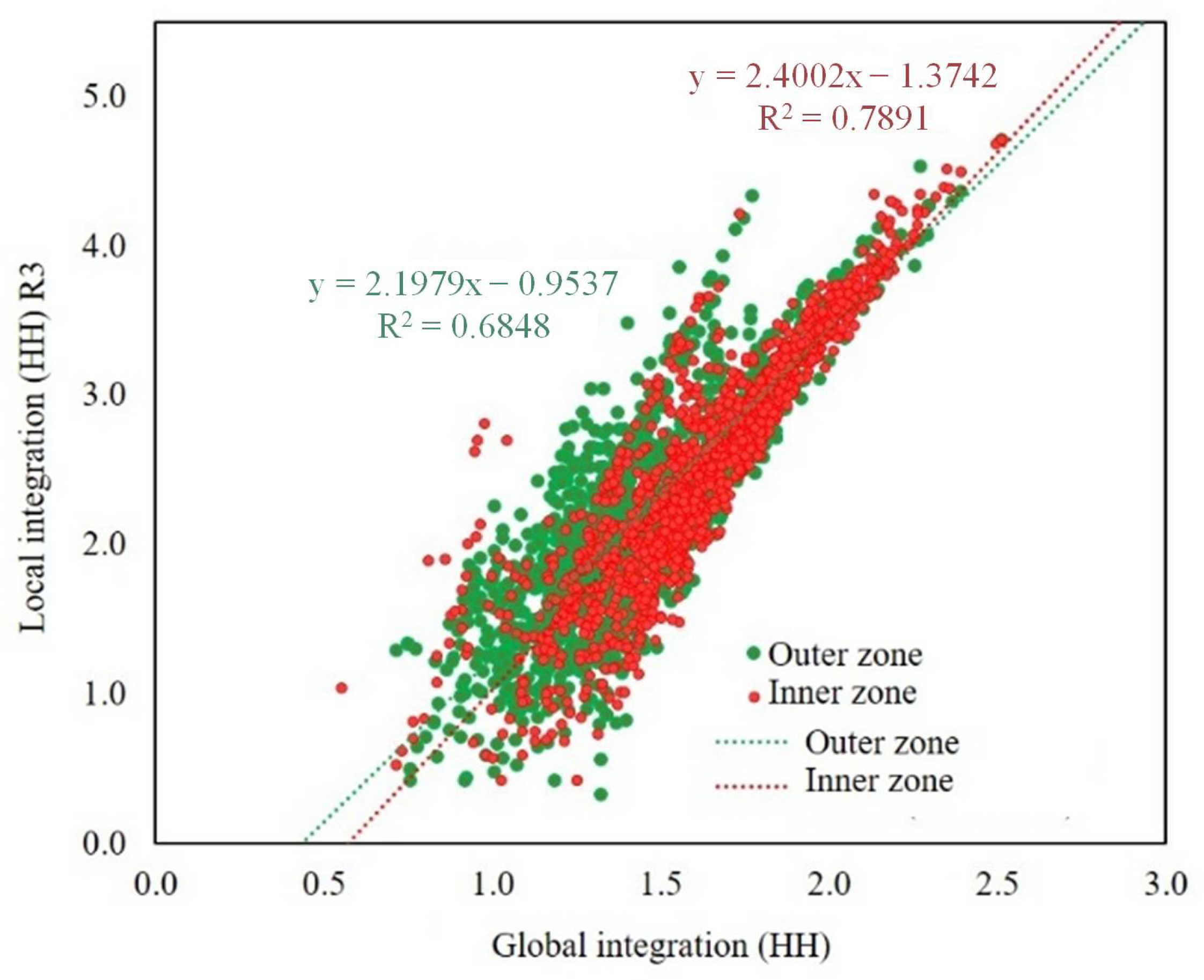
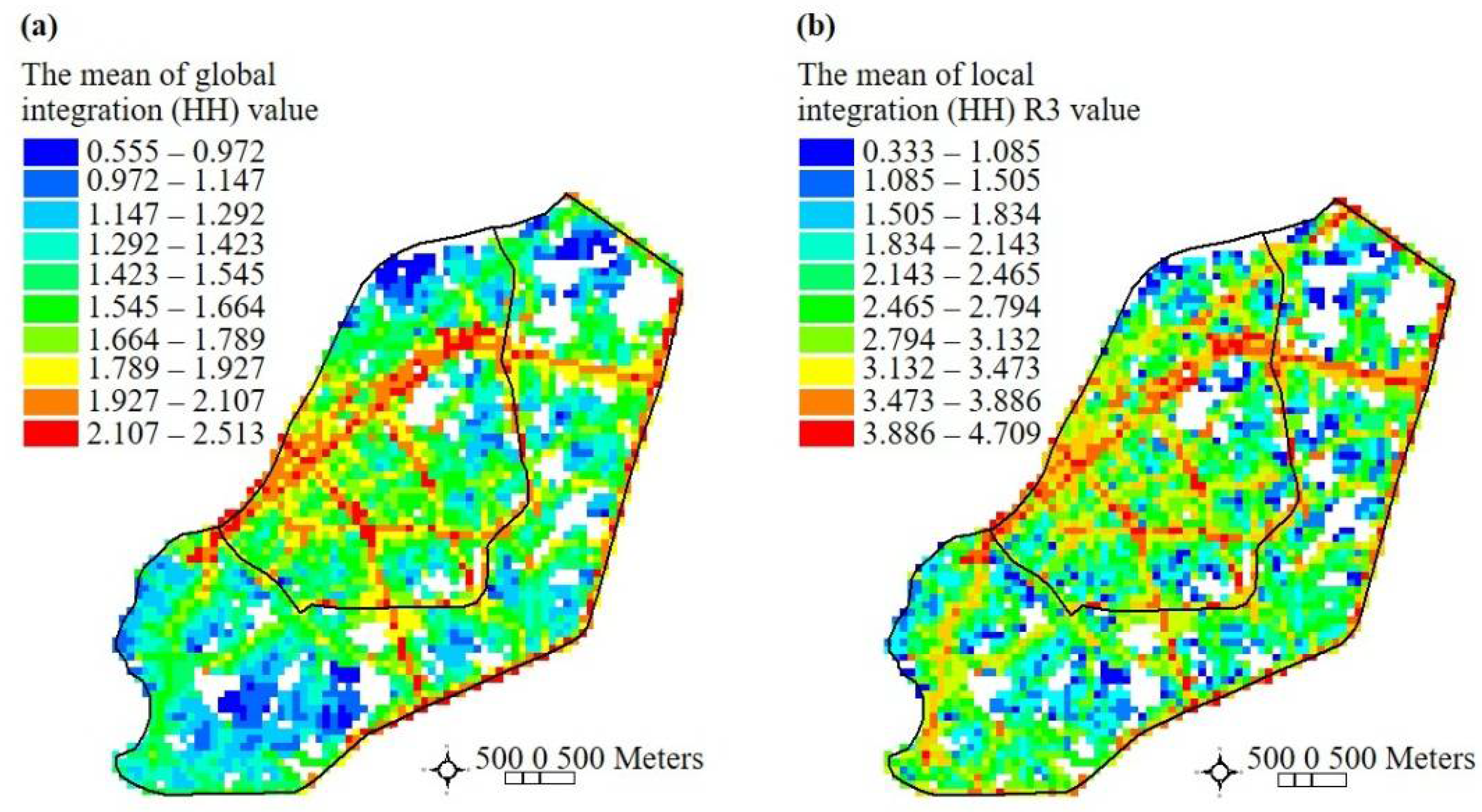
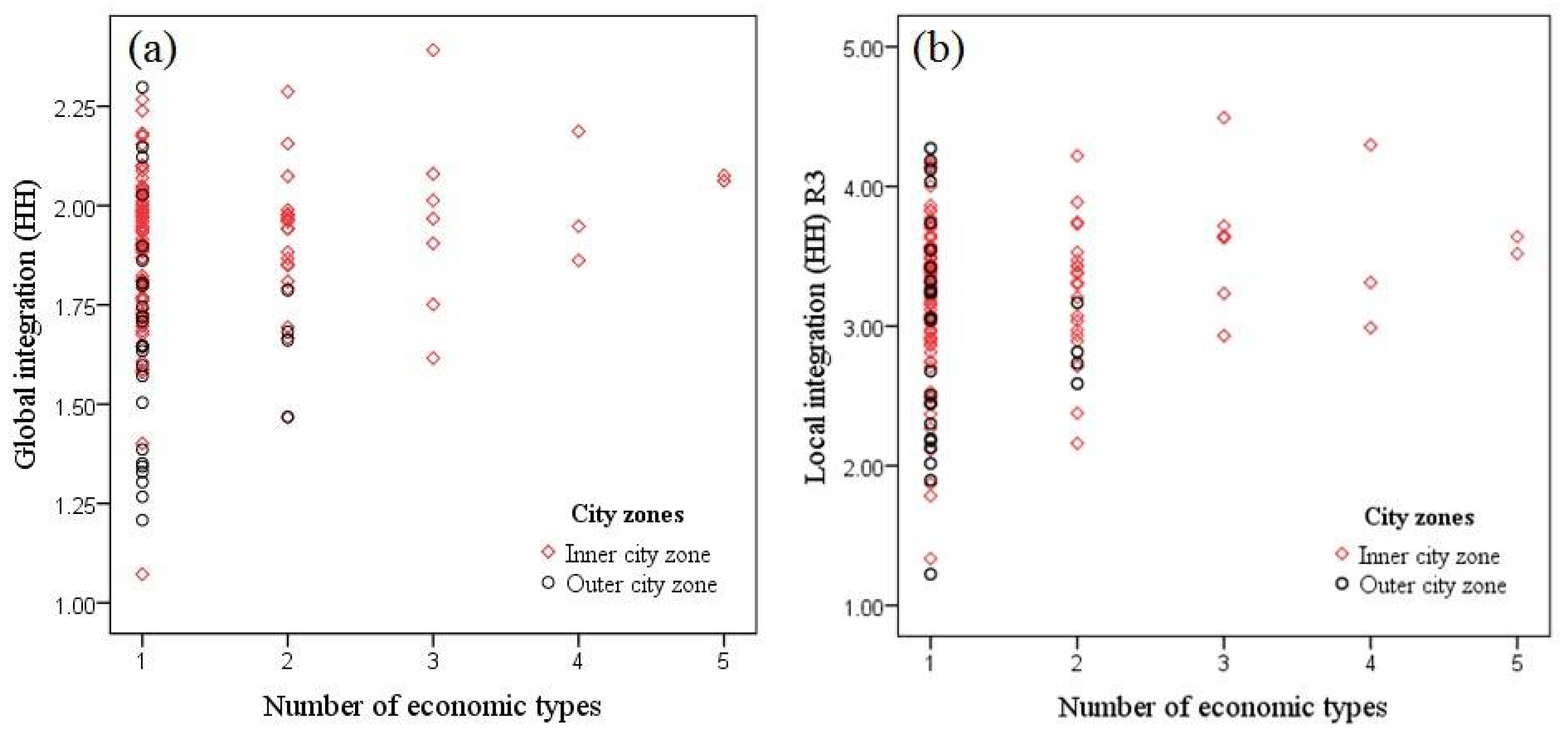
| Space Syntax Values | Inner-City Zone | Outer City Zone |
|---|---|---|
| Total number of axial lines | 1560 | 1846 |
| Axial line length (km) | 318.19 | 332.27 |
| Axial line density (km per 100 km2) | 0.24 | 0.16 |
| Global integration (HH) | 1.50 (0.31) | 1.36 (0.26) |
| Local integration (HH) R3 | 2.12 (0.89) | 1.89 (0.76) |
| Synergy coefficient | 0.7891 | 0.6848 |
| POI Characteristics | Global Integration (HH) | Local Integration (HH) R3 | ||
|---|---|---|---|---|
| Pearson’s r | p-Value | Pearson’s r | p-Value | |
| Tourism density | −0.141 | 0.150 | −0.229 * | 0.019 |
| Shop density | 0.119 | 0.225 | 0.067 | 0.500 |
| Restaurant density | 0.016 | 0.869 | 0.026 | 0.795 |
| Café density | 0.010 | 0.981 | 0.039 | 0.693 |
| Convenience store density | 0.125 | 0.205 | 0.134 | 0.173 |
| Fuel density | 0.037 | 0.705 | 0.035 | 0.725 |
| Government office density | 0.033 | 0.742 | 0.013 | 0.898 |
| Bank branch density | 0.043 | 0.663 | 0.027 | 0.786 |
| Hospital and clinic density | 0.014 | 0.890 | 0.096 | 0.331 |
| Economic diversity | 0.201 * | 0.040 | 0.149 | 0.130 |
Publisher’s Note: MDPI stays neutral with regard to jurisdictional claims in published maps and institutional affiliations. |
© 2022 by the authors. Licensee MDPI, Basel, Switzerland. This article is an open access article distributed under the terms and conditions of the Creative Commons Attribution (CC BY) license (https://creativecommons.org/licenses/by/4.0/).
Share and Cite
Srivanit, M.; Kongphunphin, C.; Rinchumphu, D. Exploring the Association of Spatial Capital and Economic Diversity in the Tourist City of Surat Thani, Thailand. ISPRS Int. J. Geo-Inf. 2022, 11, 507. https://doi.org/10.3390/ijgi11100507
Srivanit M, Kongphunphin C, Rinchumphu D. Exploring the Association of Spatial Capital and Economic Diversity in the Tourist City of Surat Thani, Thailand. ISPRS International Journal of Geo-Information. 2022; 11(10):507. https://doi.org/10.3390/ijgi11100507
Chicago/Turabian StyleSrivanit, Manat, Chompoonut Kongphunphin, and Damrongsak Rinchumphu. 2022. "Exploring the Association of Spatial Capital and Economic Diversity in the Tourist City of Surat Thani, Thailand" ISPRS International Journal of Geo-Information 11, no. 10: 507. https://doi.org/10.3390/ijgi11100507
APA StyleSrivanit, M., Kongphunphin, C., & Rinchumphu, D. (2022). Exploring the Association of Spatial Capital and Economic Diversity in the Tourist City of Surat Thani, Thailand. ISPRS International Journal of Geo-Information, 11(10), 507. https://doi.org/10.3390/ijgi11100507







